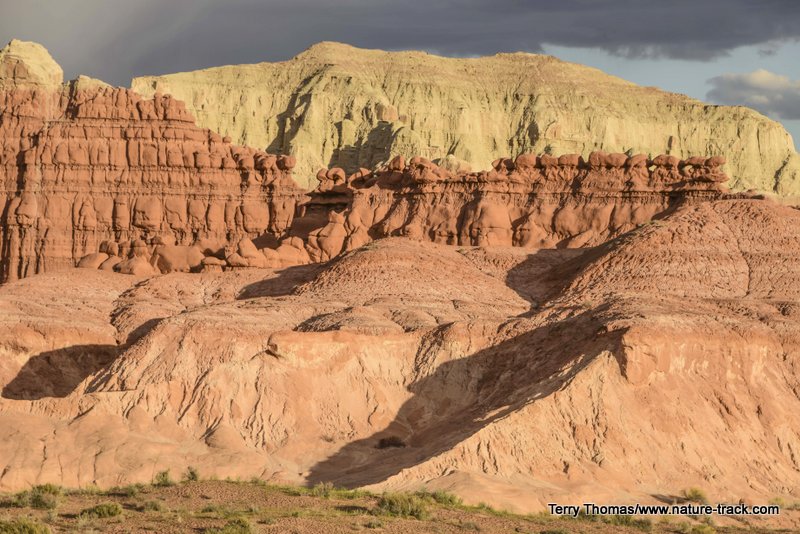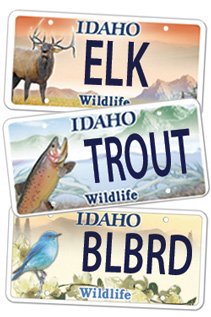Erosion

Southern Utah, like here at Goblin Valley State Park, is one of the best places to observe the raw effects of both wind and water erosion on the landscape.
If there is a word in the lexicon of ecological terms that seems to always be associated with negative consequences, it is erosion. The silt that comes from erosion is often recognized as the number one pollutant in waters that otherwise might be pristine. We are warned about erosion if we cut switchbacks on a trail. River banks erode causing property loss, damage to facilities and widen the river channel. Annually, millions of dollars are spent to reduce erosion alongside road construction projects.
There is another side to erosion though. Erosion is also the grand master of sculpting landscapes, creating art of the very earth itself. Places admired for their awesome grandeur and unique beauty, places we often revere as national parks, owe their existence to erosion. Think of Bryce, Zion’s, Arches or Grand Canyon national parks. We would never know their names if not for erosion.
Water and wind are the elemental agents of erosion. Working separately or together, these seemingly fluid forces can whittle mountains into hills, streams into chasms and sandstone into shapes.
Erosion is an irresistible force and virtually everything eventually succumbs to it. Softer surfaces yield quickly and erosion can rapidly create astounding designs or remove features all together.
Harder, more resilient surfaces erode more slowly. Hard is a relative term though and the erosive force will follow the path of least resistance, seeking out the softer materials. It carves out the softest rock and soil and shapes and smooths the harder stone. In the process, it creates holes and arches, hoodoos and slot canyons, and massive buttes and mesas.
Sometimes erosion is simply a workhorse. It grinds up parent rock grain by grain and sends it downslope. Millions of years ago, what we now call Great Smoky Mountains National Park was a range of granite peaks far higher than today. Once tectonic pressure stopped pushing them upward, erosion, helped out by freeze-thaw cycles and likely glaciers, dismantled the tops grain by grain, grinding them down to stunning rounded hills, the highest of which is around 4,000 feet ASL. Bit by bit, the mountain tops end up in the valleys creating deep fertile soil. The Teton Range is in the same process and a couple of million years climbing the Grand may be a stroll not a technical climb.
The river drainage erosion that we are so quick to condemn is also the process by which wildlife-rich river deltas are formed. Sediment rolls downstream settling out only as the river slows to discharge into an ocean or lake. On larger river systems, these deltas may cover many square miles and help to protect shorelines from ocean-bred storms.
If erosion teaches a virtue, it is that of patience. A dripping spring has little effect when observed in a human lifetime. But over the course of many millennia, this same drip carves a canyon, one flake of rock at a time. Windblown sand abrades slowly through eons, wearing through the surface until, one day, all that is left is an arch of rock, a hundred feet tall and equally wide. And although we can’t see it or even measure it, the same processes continue today. Our monuments are tomorrow’s ruins.
When great sculptors are listed, Erosion is not likely to be among them. But the finest monuments in the world are beholden to this relentless shaper of the surface of the earth.
Wildlife License Plates
Great news! as of 2024, there are three NEW designs for license plates. They still are bluebird, cutthroat trout and elk, but they are beautiful.
Idaho Wildlife license plates provide essential funding that benefits the great diversity of native plants and wildlife that are not hunted, fished or trapped—over 10,000 species or 98% of Idaho’s species diversity. Game species that share the same habitats (such as elk, deer, antelope, sage-grouse, salmon, trout) also benefit from these specialty plates.
No state tax dollars are provided for wildlife diversity, conservation education and recreation programs. Neither are any revenues from the sale of hunting or fishing licenses spent on nongame species. Instead, these species depend on direct donations, federal grants, fundraising initiatives—and the Idaho Wildlife license plates.
Both my vehicles have Bluebird Plates. I prefer the bluebird because the nongame program gets 70 percent of the money from bluebird plates, but only 60 percent of the money from elk and trout plates - 10 percent of the money from elk plates supports wildlife disease monitoring and testing programs (to benefit the livestock industry) and 10 percent from cutthroat plates supports non-motorized boat access.
Incidentally, in 2014, the Idaho Legislature denied the Department of Fish and Game the ability to add new plates or even to change the name of the elk and cutthroat plates (very specific) to wildlife and fish plates, a move that would have allowed for changing images occasionally and generating more revenue. It would seem that they believe that we Idahoans don't want a well funded wildlife program.
I think it is time we let the Legislature know that Idahoan support wildlife funding and that we would like to see these generic plates come to fruition.

Wildlife License Plates
Great news! as of 2024, there are three NEW designs for license plates. They still are bluebird, cutthroat trout and elk, but they are beautiful.
Idaho Wildlife license plates provide essential funding that benefits the great diversity of native plants and wildlife that are not hunted, fished or trapped—over 10,000 species or 98% of Idaho’s species diversity. Game species that share the same habitats (such as elk, deer, antelope, sage-grouse, salmon, trout) also benefit from these specialty plates.
No state tax dollars are provided for wildlife diversity, conservation education and recreation programs. Neither are any revenues from the sale of hunting or fishing licenses spent on nongame species. Instead, these species depend on direct donations, federal grants, fundraising initiatives—and the Idaho Wildlife license plates.
Both my vehicles have Bluebird Plates. I prefer the bluebird because the nongame program gets 70 percent of the money from bluebird plates, but only 60 percent of the money from elk and trout plates - 10 percent of the money from elk plates supports wildlife disease monitoring and testing programs (to benefit the livestock industry) and 10 percent from cutthroat plates supports non-motorized boat access.
Incidentally, in 2014, the Idaho Legislature denied the Department of Fish and Game the ability to add new plates or even to change the name of the elk and cutthroat plates (very specific) to wildlife and fish plates, a move that would have allowed for changing images occasionally and generating more revenue. It would seem that they believe that we Idahoans don't want a well funded wildlife program.
I think it is time we let the Legislature know that Idahoan support wildlife funding and that we would like to see these generic plates come to fruition.

"WOW. What a phenomenal piece you wrote. You are amazing." Jennifer Jackson
That is embarrassing, but actually a fairly typical response to my nature essays. Since The Best of Nature is created from the very best of 16 years of these nature essays published weekly in the Idaho Falls Post Register (online readership 70,000), it is a fine read. It covers a wide variety of topics including humorous glimpses of nature, philosophy, natural history, and conservation. Readers praise the style, breadth of subject matter and my ability to communicate complex and emotional topics in a relaxed and understandable manner.
Everyone can find something to love in this book. From teenagers to octogenarians, from the coffee shop to the school room, these nature essays are widely read and enjoyed.
Some of the essays here are my personal favorites, others seemed to strike a chord with readers. Most have an important message or lesson that will resonate with you. They are written with a goal to simultaneously entertain and educate about the wonderful workings of nature. Some will make you laugh out loud and others will bring a tear to the eye and warm your heart.
Readers Write:
"You hit a home run with your article on, Big Questions in Nature. It should be required reading for everyone who has lost touch with nature...great job!" Joe Chapman
"We enjoyed your column, Bloom Where Planted. Some of the best writing yet. The Post Register is fortunate to have your weekly columns." Lou Griffin.
To read more and to order a copy, click here or get the Kindle version
Copies are also available at:
Post Register
Island Park Builders Supply (upstairs)
Barnes and Noble in Idaho Falls
Harriman State Park, Island Park
Museum of Idaho
Valley Books, Jackson Wyoming
Avocet Corner Bookstore, Bear River National Wildlife Refuge, Brigham City, Utah
Craters of the Moon National Monument Bookstore, Arco, Idaho